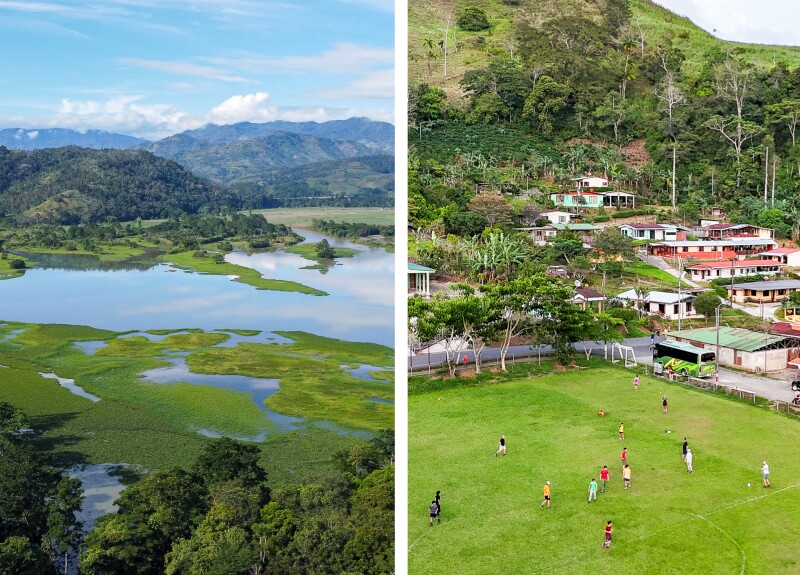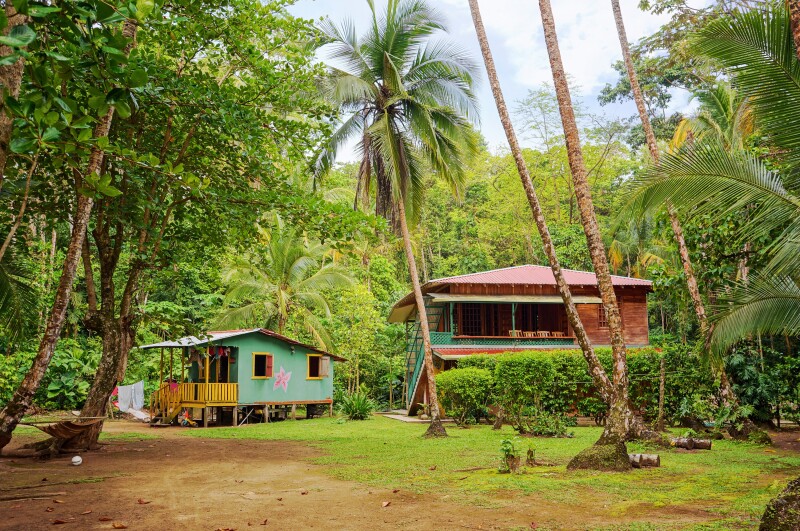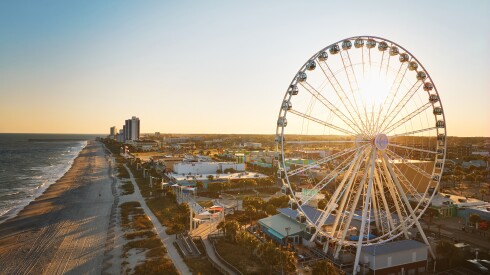Despite overwhelming demand for all things Costa Rica from tourists, the Central American country has a wildness that’s carefully preserved, no matter how many international airports are built. (At present, there are two in the works—one on the Osa Peninsula, and one on the Caribbean coast—which, upon their completion, would double the current number.) This remains a place where crabs crawl out of the water at sunset, stingrays swim around surfers in the Pacific, and languidly smiling sloths—the national mascot—remind us all to slow down.
Costa Rica works hard to maintain its pristineness, with 26 percent of its landmass under governmental protection. In a notable recent example of how seriously the country takes conservation, a consortium of partners from the public, private, and academic spheres came together to figure out how to return reclaimed seashells to the beaches whence they came. (More on this below.) Thanks to efforts such as this, you’re safe in thinking that the more things change in Costa Rica, the more they stay the same. Here are some of those new ways to experience old wonders in Costa Rica right now.

Hikers on El Camino de Costa Rica can see everything from preserved wetlands to locals playing soccer on a village field.
Courtesy of UrriTrek
Walk from coast to coast on the country’s own “camino”
Mar a Mar, a nonprofit dedicated to rural development, has teamed with the Costa Rica Tourism Board to blaze a new trail: El Camino de Costa Rica, a 174-mile hike from the Caribbean to the Pacific coast. Trekkers often take around 16 days to walk the entire route—although experienced hikers can do it in about 11 days. No matter your pace, you’ll pass through two dozen rural or Indigenous villages and all manner of microclimates: beaches and mangroves, rainforests and cloud forests, pineapple and palm plantations. For the ultimate hike, consider going with a guide from Urri Trek, a local operator that can handle booking your accommodations (be it homestays or hotels), arranging meals, and ferrying luggage from village to village. Best of all, your guides will connect you with members of the community, so you’re breaking bread (or in this case, sharing gallo pinto) with locals, rather than just tramping through their backyards.

The pool deck at Nekajui, a Ritz-Carlton Reserve, overlooks the Gulf of Papagayo.
Courtesy of Nekajui, a Ritz-Carlton Reserve
Check into a new or newly renovated hotel
On Guanacaste province’s biodiverse Peninsula Papagayo, where the Pacific laps calmly at the shore and howler monkeys play in the trees above, several new luxury hotels have committed to opening alongside the Four Seasons and Andaz. The splashiest debut has been Nekajui, a Ritz-Carlton Reserve, whose name translates to “lush garden” in the local Chorotega dialect. “This is the world’s eighth Ritz-Carlton Reserve—Marriott’s ultra-luxurious collection of resorts in remote locales that focus on nature and culture—and it’s the first in Central and South Americas,” reports Afar’s Katherine LaGrave, who visited the hotel when it opened earlier this year (read her full review). Nekajui’s 107 guest rooms and suites all face the ocean, LaGrave notes, while three treetop suites offer something special for “adventurers who appreciate the finer things.”
That’s just the start: Six Senses Resort and Spa Papagayo is set to open in October, marking the debut of the high-end wellness hotel brand in Central America. This Afar Travel Vanguard recipient considers experiencing biodiversity one of life’s great luxuries, so expect an immersive experience across 41 secluded pool villas and an on-site organic farm. Meanwhile, work continues on the One&Only Papagayo, an ultra-luxury 167-room hotel with residences surrounded by capulin trees and Papagayo Bay views that’s expected to open in early 2026. Groundbreaking on a new St. Regis, with 120 rooms and a whopping 143 residences across nearly 50 acres on the Gulf of Papagayo, begins this summer, with the hotel (rather optimistically) projected to be finished in 2027. Lest you wonder how all these high-luxury developments will affect the local environment, the Costa Rican government mandates that 70 percent of the land on this peninsula must be protected—always.
Not far away, on Playa Penca, Costa Rica’s first Waldorf opened its doors on May 1. Two- and three-bedroom villas are the hallmark of the Waldorf Astoria Punta Cacique, along with a multi-tiered pool, a vibrant kids club, and seven bars and restaurants.
Looking for a more intimate beach retreat? Head south of Guanacaste to the Nicoya Peninsula, where Hotel Nantipa, a 29-room boutique property and member of the Small Luxury Hotels of the World collection, is gaining attention for its eco-luxury. The owners are committed to sustainable practices (donations at checkout and beach cleanups, to start), helping to protect what makes boho beach town Santa Teresa special.
In the country’s interior, Nayara Gardens, the family-friendly resort that’s part of Nayara’s trifecta of properties overlooking Arenal volcano, reopened in 2024 after transforming its rooms into casitas with private plunge pools with a breezy, tropical vibe. This hotel continues to rank among my favorites in the world due to its incredible service. (Bonus: It’s on the site of a sloth sanctuary, meaning you might see the animals napping outside the spa.)
Lastly (for now, anyway), the Retreat Costa Rica—a hotel and spa outside San José that’s the brainchild of chef, nutrition expert, and author Diana Stobo—has unveiled its $4 million expansion. Updates include an open-air clubhouse with two new restaurants, 10 luxury lofts, and holistic wellness programs such as “The Art of Resting” and “The Big M: Mastering Menopause.”

The Gandoca-Manzanillo National Wildlife Refuge, near the Carribean coast town of Manzanillo, is home to jungle, wetlands, and a protected coral reef.
Photo by Damsea/Shutterstock
Cultural exchange in Puerto Viejo
Costa Rica’s Caribbean coast is less well trod by U.S. travelers, in part because it can be a four- to five-hour drive from San José’s airport. There’s a gem of a town on the southeastern side, however, that makes the trip worth it. Puerto Viejo has all the Costa Rican calling cards, including a big surf break (Salsa Brava), a national wildlife refuge (Gandoca-Manzanillo), and sloth reserves. This area is known for its thriving Afro-Caribbean community, and travel agency Costa Rican Trails has launched four immersive experiences that embrace food, culture, and connection. Prepare patacones (twice-fried plantains) with chef Doriam at Cahuita’s Taste, take a salsa lesson with a professional dancer, learn the legacy of calypso with the Kawe Calypso bandleader Donald “Danny” Williams, and enjoy a beach picnic backed by a calypso band.
Catch one of the new year-round direct flights from North America
As of December 2024, Alaska Airlines now flies direct from Seattle to Liberia, the closest entry point to Peninsula Papagayo and many other Pacific Coast destinations. United now flies direct from San Francisco to the capital city, San José. In December 2025, Canada-based Porter Airlines will fly direct from Toronto and Ottawa to Liberia.
Practice proper shell etiquette
Speaking of flights, in 2023 Costa Rica’s international airports saw the confiscation of an estimated five tons of seashells from departing travelers. Taking shells—which are usually buried at the airport after they’re confiscated—is considered illegal wildlife trafficking here, and in response to that mind-boggling number, the Ministry of Environment and Energy, the University of Costa Rica, airport management company Aeris, and Imperial beer teamed up to launch the “De Vuelta a Casa (Back Home)” initiative. Using an AI app that was trained on 18,500 user-provided photos of 525 species, the program has been able to classify more than 30,000 seized shells, with 90 percent accuracy, and return them to the areas of the coasts where they belong.
Of course, this wonderful technological advancement is unnecessary if visitors simply follow the tenets urged by Costa Rica Tourism: Respect wildlife habitat, leave it undisturbed, and carry it in your heart, not your hands.











